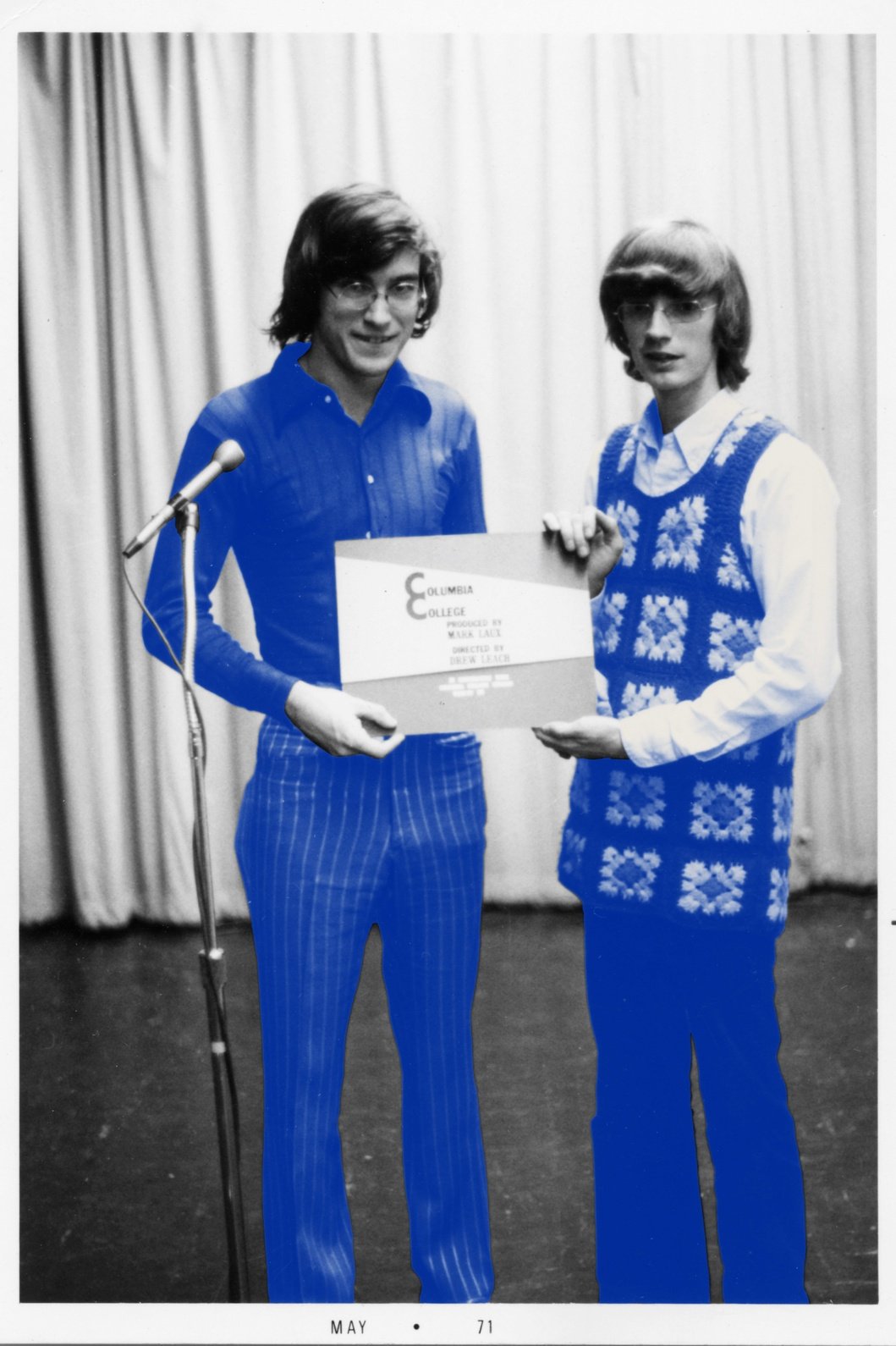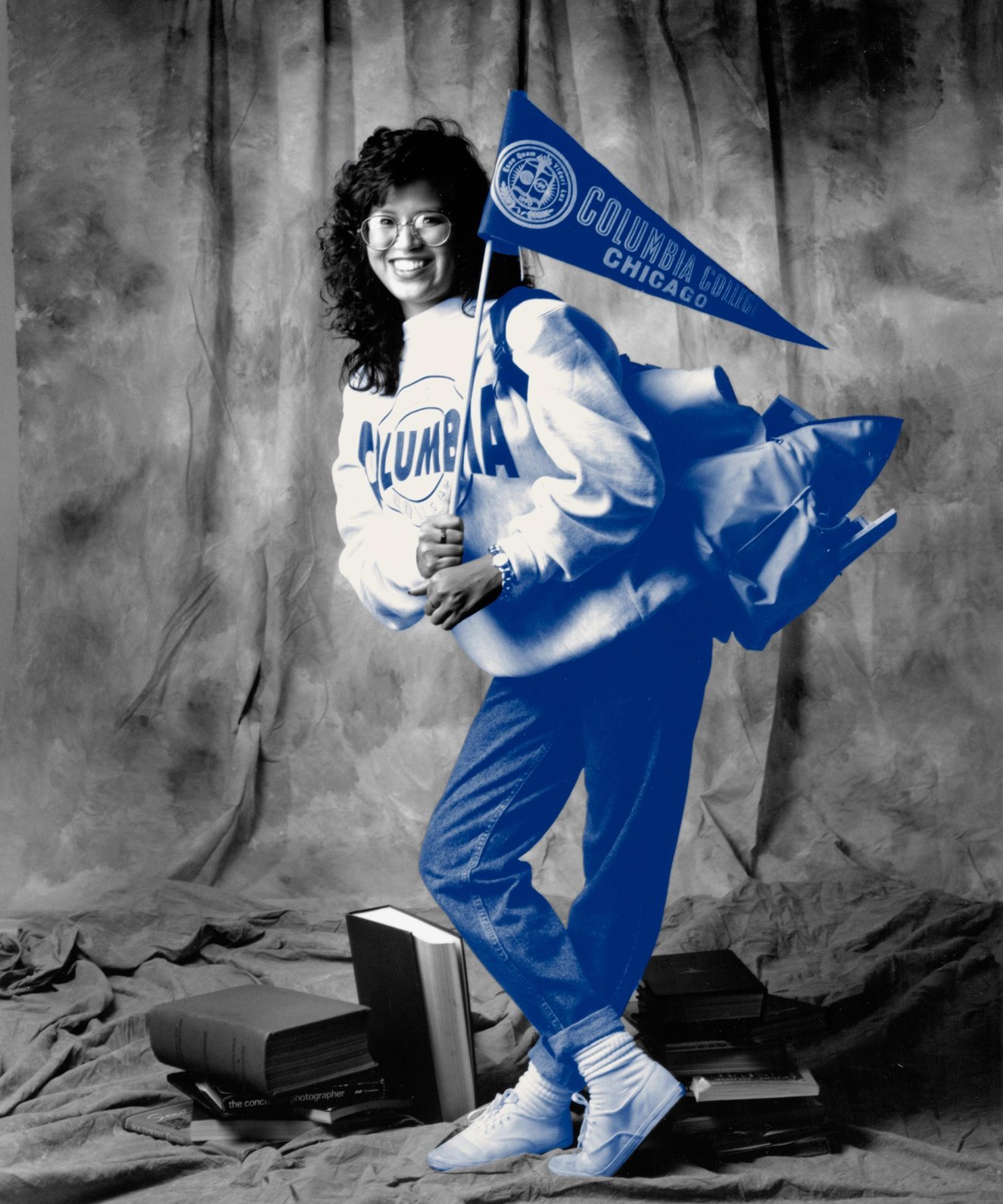
What We Wear
College campuses have long been incubators of style. Stepping away from the comfort and familiarity of home, we enter an environment that encourages self-discovery—one where we can experiment not only with ideas but also with identity, including how we dress.
More than just clothing, what we wear is a reflection of our identities, passions, politics, and the unique character of our campus culture. Each campus has its own distinct sartorial language, shaped by local influences, student subcultures, and the ever-evolving trends that sweep through dorms and classrooms. Columbia has been known for its progressive curriculum and enlightened commitment to creativity and innovation since its founding in 1890. How, then, might we describe Columbia College Chicago style?
Just as our student body represents a wide range of backgrounds, experiences, and perspectives, Columbia’s campus style could be described as eclectic, boundary-pushing, and unapologetically original—an ever-changing reflection of the artists, designers, writers, and performers who call it home. Here, fashion is as much a form of storytelling as filmmaking, photography, or design.
What We Wear: 135 Years of Columbia Style is a retrospective and a celebration of the innovative and individualistic fashions worn by our students from 1890 to today. It places archival photographs depicting students at work, leisure, and play in conversation with a selection of looks from the college’s Fashion Study Collection. Together, these images and garments illuminate how Columbia students have long used fashion as a tool of self-expression while also redefining what it means to dress for campus life.
The Fashion Study Collection at Columbia College Chicago was founded in 1989 and has grown to more than 6,000 items. It houses an exceptional collection of fashion history, designer garments, and dress from around the world. As a hands-on, academic, and inspirational resource for students, faculty, and the public, the Fashion Study Collection supports teaching and learning across disciplines through the exploration of dress and its relationship to history, culture, art, design, business, and technology.
This exhibition is a collaboration between College Archives & Special Collections, The Fashion Study Collection, and the Gallery Management Practicum course.
What We Wear: 135 Years of Columbia Style
Curator: Lauren Downing Peters
Exhibition Design, Installation, and Website: Students in Gallery Management Practicum (BUSE 481/581): Astrid Houze de l’Aulnoit, Jessica Ochoa-Morales, Indiya Roberts, Evelyn Salgado, JJ Salgado
Fashion Study Collection Interns: Grace Cali, Charlee Lambert, Anya Tapley
The Gallery
1900s
In 1890, when Columbia College Chicago was founded, women’s fashion was on the precipice of a significant evolution that reflected their changing roles and civil rights.
As women became more active and equal members of American society, rigid corsets and crinolines were traded for more casual, youthful, and wearable styles. The looks here illustrate that shift. The taupe skirt and white shirtwaist, which date to approximately 1900, recall the carefree styling of the Gibson Girl—the fashion icon of the day. The white cotton day dress would have been worn slightly later, between 1910-1915, and illustrates the softer silhouettes (and shorter hemlines) that grew in popularity during World War I.
Similar styles would have been worn by Columbia’s co-founders, Mary Blood and Ida M. Riley.
1920s
The 1920s welcomed an overarching simplicity never before seen in women’s fashion. Androgynous styling and sportswear-inspired looks, such as the navy blue dress and matching jacket shown here, enjoyed massive popularity amongst female coeds eager to embrace the la garçonne look made famous by Coco Chanel.
Men’s fashion went in a similarly sporty direction. Cropped, wide-legged trousers known as “Oxford Bags” became a campus trend in the United States where they were paired with looser-fitting blazers, sweater vests, and two-tone shoes.
As Columbia embraced a new motto in 1928, “To be rather than to seem,” student styles reflected a desire for ease and modernity that reflected their desire to define themselves in a rapidly modernizing world.
1940s
During World War II, campus fashions adapted to wartime austerity measures with practical tailoring that made the most of limited resources.
This trim women’s skirt suit reflects the era’s emphasis on utility—shorter hemlines, narrow silhouettes, and minimal embellishments—but it doesn’t skimp on style. Shoulder pads, nipped-in waists, and sharp tailoring conveyed strength in the face of adversity.
For students at Columbia College Chicago and beyond, fashion balanced resilience with self-expression, as young people navigated wartime realities while maintaining a sense of identity and sophistication in both the classroom and daily life.
1950s
Campus style in the 1950s was defined by preppy styling cues taken from America’s Ivy League campuses. Letterman jackets, natty trousers, and polished loafers were closet staples amongst male students, while female students favored pencil skirts, smart cardigans, and classic pearls.
As Dior’s luxurious “New Look” silhouette, with its cinched waist and voluminous skirt, dominated the fashion press, some students pushed back against what they saw as excessive indulgence so shortly after wartime austerity. In Chicago, for instance, the “Little Below the Knee Club” protested Dior’s opulence. While no such protests are documented at Columbia College Chicago, students were keenly aware of these evolving fashion debates.
1960s
The 1960s were a period of upheaval and transformation on America’s college campuses. A surge in student activism—fueled by anti-war protests, the Civil Rights Movement, and demands for greater freedom of speech and thought—reshaped academic and civic life.
Campus fashions both reflected these changes and were utilized as a medium of resistance. In the late 1960s, a growing number of students began donning surplus military apparel, like the M-65 field jacket displayed here, to protest the Vietnam War. The 60s also saw American students break with tradition, rejecting the polished styles of their parents’ generation, and embracing a carefree, undone look that reflected this spirit of rebellion and change.
1970s
During the 1970s, college campuses were incubators for the free-spirited, earthy aesthetic often associated with the hippie movement.
Students donned patched bell bottoms, embraced the handmade—from crochet to tie dye—and rejected mass consumerism by thrifting their clothes. Campus fashion during this era was both deeply personal and political; it wasn’t uncommon for students to customize their clothes or to wear political buttons or slogan t-shirts. Clothing was both a means of self-expression and a reflection of one’s values. At Columbia College Chicago, as on campuses nationwide, men and women also adopted a shared sartorial language of jeans and t-shirts that blurred traditional gender norms and embraced authenticity.
1990s
In the 1990s, Columbia’s campus fashions bore little resemblance to the neat suiting and conservative dresses donned by its earliest graduates. In this decade, more than any other, students could identify like-minded peers through their self-fashioning.
Looks were layered, thrifted, and often purposefully deconstructed, rejecting mainstream trends in favor of artsy authenticity. Eclectic subcultural style—from grunge to bohemian—and streetwear were omnipresent across Columbia’s expansive South Loop campus, reflecting the college’s diverse, creative community.
Bearing the motto, “Clothing without Prejudice,” the Cross Colours ensemble displayed here is a reflection of Columbia’s progressive and inclusive ethos at the end of the millennium. For many Columbia students, clothing had become a vital extension of their creative practice.


















